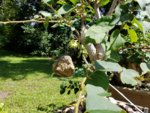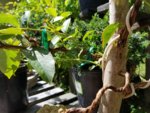Thanks for the input! Can't see it in photos, but box is up on bricks supported by a couple of 2x6's perpendicular to bottom slats so it's not touching ground - so no chance of tap roots forming, just lots of fine feeder roots. I've dabbled with this species before for landscape plants and found that it's best not to mess with new shoots, they have a tendency to "pop" off if too much pressure is applied in their first year. I'm going to apply more of a "clip and grow" method to this plant so I don't have to worry about popping off branches, but I may apply some guy wires in the future if I need the growth to be more horizontal than it is. This is all speculation of course, my main concern now is feeding and building up the plant enough to make it through this coming winter after such a drastic reduction. I'll post an update pic tomorrow once it's light out. Been meaning to post more since my uppity post
#22 in the "shoutout" thread, but life it seems always has a habit of getting in the way of the stuff that really matters. Luckily that's all resolved now - New job, new outlook, new bonsai scheduled.
Haha I know what you mean (I always like thinking of it as a dichotomy of "
urgent versus
important" stuff to help me prioritize, am ADHD as hell so it only goes so far

)
Re fearing that 'pop', I know all-too-well what you mean!! I collect and propagate to get my trees (have only a handful of purchased specimen), and in most cases this entails me having to 'build branches from scratch' and some species are very prone to 'the pop', hell I thought I had crape myrtle wiring down until a few weeks ago when trying
slightly more lignified areas and popping several branches I'd spent >1yr growing, so damn frustrating!!! That said, I approach initial branch-development differently than
@Hartinez , I find that you really lose the ability to change the angle of the branch-collar once you've let the branch lignify...sure, you can wire it after, but the angle it leaves the trunk is virtually fixed (and aggressive moves here are real dangerous, at least IME the branch-collar of new shoots are a 'fracture point'! I go through TONS of zip-ties, I'll tie shoots to other shoots, to the trunk, to the roots, to hooks or nails on the box, whatever, to gently guide the orientation of the branch,
before wiring would be appropriate.
Have you ever used zip ties? I've found them to be my best go-to for fast, crude manipulations - just for getting things oriented a bit better, it lets me fly through the garden correcting a lot of improperly-angled shoots
as they're young and supple (and the zip-ties stay on as long as necessary, the precision of adjustment they offer is great insofar as not snapping stuff, in that once you've 'set' the zip-tie you can fine-tune the angle of harder stuff w/o popping it if you just pay close attention while doing it!) I'll also use rock 'ornaments' on occasion to drag-down heavier branches, although for those my go-to is to simply put S-hooks or even nails along the perimeter of the box's top, will just put one wherever I need an anchor-point, and then use either zip-ties or rope to tie-down branches....this may be annoying BUT it lets me do things I wouldn't be able to do otherwise, there's simply bends you cannot make once things are set that you
could have made earlier, and to that end I've been experimenting with a "purple porterweed" bonsai, this isn't even a tree and is just a pet-project but the stems on this, once halfway-lignified, become 'poppy', and once set there is *no* bending at-all, they're the most 'poppiest' specie I've worked with (which is why I've been spending so much time on my experimental bonsai porterweed!), anyways I've developed my primaries & secondaries on this otherwise-apically-dominant specimen in such a way that they're now set (for a time, at least!) in horizontal planes instead of vertical, I probably have to mess-around with the zip-ties once a week, either adding more or doing adjustments to already-placed ties on my test-porterweed-'bonsai' (and it's working!!)
Then, once things are starting to lignify, I'll wire- right as they're starting to lignify is best IME, so long as you're ok re-applying in not-that-long! (at least here in FL, where things grow like crazy!!)
For example of how well you can use zip-ties, here's a normal porterweed, not tended in months (except topping it at ~14", flat cut of the canopy to keep it from top-heavy), they just shoot straight-upward:

Alternatively, here's a close-up of my 'bonsai porterweed', a project where I'm frequently clipping & zip-tying my way to a 'proper branch structure' (for a non-tree, lol!) am using the surface roots as my anchor-points as it's not in a box but a large ceramic container, am unsure but expect this will actually help give a cooler surface-root profile too:

This thing grows so strong and back-buds so readily (on any degree of hardened wood!) that it takes to 'ramification pruning' so well that I couldn't resist trying to make a temporary bonsai out of it for fun, am unsure if I'll be able to get a sparse-but-complete full canopy by the end of this summer but if not, mid-summer next year and I'll have the only porterweed bonsai I've been able to find (google images shows none!), will be a 'standard upright' with a domed top that's 80% as wide as the container it's currently in:

I expect that, when it's ready (ie, I've satisfactorily finished my secondary&tertiary structure and have transitioned into 'hedge'/'shape'-pruning it), I'll probably re-pot it / finish-prune it / take its picture, and by the next day or two it'll already be an unkempt 'fro!! They're just such rampant growers- and they POP worse than anything I've seen (worse than papaya trees!), it's still growing crazy vigorous right now so I *may* get to finish it this year otherwise early next year, at which point I'll be done with it but will have grown out a 'tree' entirely by directing growth
as it occurred which is what I've been trying my hardest to get good at (have too-many large pieces of stock that I'm growing, don't want to look-back in 3yrs and think "why did I let every primary grow straight upward?!?")
As mentioned, rocks are sometimes very useful and faster/easier than wire IMO, it's not nearly as often but for instance a rock was much simpler for what I needed here:

Also took a pic of a crape-cutting I'm developing initial branches on, have wired the primaries because I needed shape (if I were *only* combating apical-tendencies on a crape - which seems to be a bit of what you have, ie apical tendencies you're afraid of popping - I'd be wedging smooth rocks between the base of the branch and the trunk, this works **very** well to change branch-angle, relative to trunk, by up to at least 25-35degrees, so on strongly apical trees I find this indispensable in the first weeks of shot-growth when they're just finding their angles and 'setting their collars' into position, once the collars are set the branch-angle relative to trunk is WAY harder to change, and is an inherently dangerous spot to do strong bends on!) I'd wired the primaries but the new, supple shoot on the left-primary is being zip-tied (twice, green zip-ties) to that primary to force it in that general direction, for the eventual 'pad' that'll be there, before the collar has set in the vertical position it otherwise would have!)

And here's my 'box's edge with nails/screws/hooks' approach, just set them wherever I need anchor and wire (I'll put padding over the branch if it's a thin wire!!)

^that's more for preventing future upward-angling of already-set branches, really....while these techs help to
start the branch that way, given enough time it'll start making itself more vertical if the specie has strong apical tendencies!
[just noticed a red lava-rock/scoria 'rock ornament' in the center, that'd be slid up that supple shoot its on in ~3-6 days, whenever it's strong enough to handle that light ornament at ~3-5" out from the trunk w/o worry it'll bend downward!! The large rocks stay in-place, the small ones, not so much, haven't been using those much anymore but opting for zip ties in such instances instead!]
--------------
Would love to see new pics!! Will have to browse around for this 'shoutout' thread you speak of

Good luck with the job- and everything else!!
)














